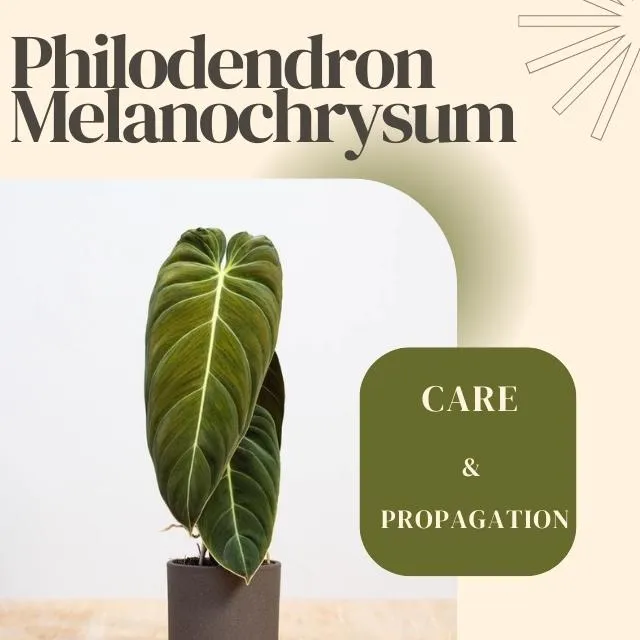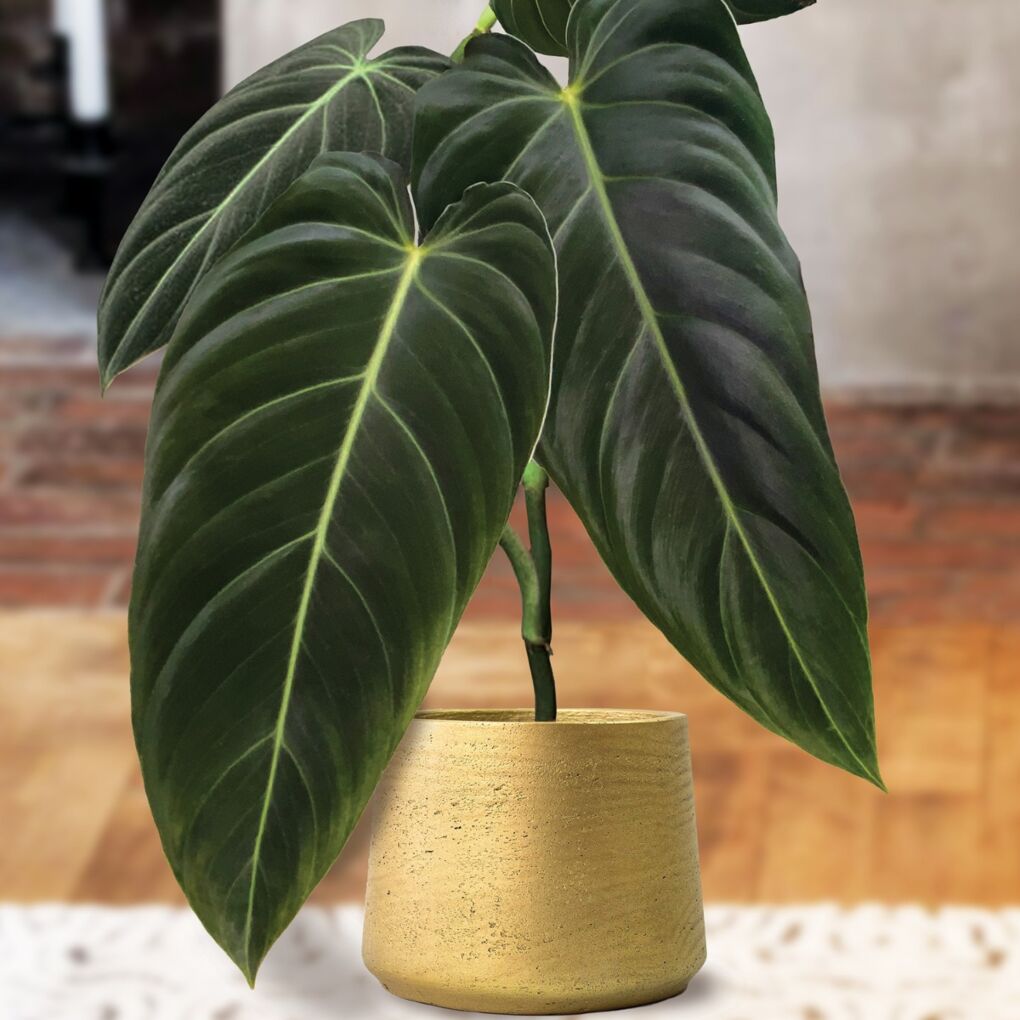The genus name of Philodendron comes from the Greek words “Philo” and “dendron,” which means “love or affection” and “tree.” The genus consists of more than 450 types, which grow in the tropical locales of the Americas. The word melanochrysum, comes from the Greek word “melano,” which implies dark, and the Greek “chrysum,” which means gold.
The Philodendron melanochrysum is a rare type of delightful tropical plant. It doesn’t get the credit or the attention it deserves. The almost black glass-like leaves flaunt a dazzling yellow vein hence the name Melanochrysum. The yellow vein follows its direction through the leaf to shape a unique pattern. The glass-like appearance on the leaves looks like spots of gold.

Characteristics of Philodendron Melanochrysum
The plant has dark green velvet leaves with a beautiful yellow vein that creates a unique pattern by outlining its way across the leaf.
New or youthful leaves frequently have an orange or red color, changing to dim green as they mature.
| Scientific name | Philodendron melanochrysum |
| Family | Araceae |
| Genus | Philodendron |
| Habitat | South America |
| Growth Habitat | Climbing Perennial |
| Common names | Black-gold philodendron, melano plant |
There are many similar plants and varieties of Philodendron Melanochrysum. Some of them are:
- Philodendron Hederaceum
- Philodendron Imperial Green
- Philodendron Micans
- Philodendron Green Congo
- Philodendron Mamei
- Philodendron Verrucosum
Care Guide for Philodendron Melanochrysum
A simple to focus on plant that will thrive under the appropriate circumstances, follow these tips for Philodendron Melanochrysum care.
Light Requirements
Philodendron melanochrysum typically develops best in bright and indirect light. Direct sunlight is harmful to the leaves as it may burn them.
Try not to expose these tropical plants to delayed times of direct daylight.
Temperature Requirements
Philodendrons are tropical plants adjusted to hotter temperatures and higher humidity. Any room above 60℉ (15.50C) ought to be acceptable for the plant to develop well. The best temperature range for a healthy plant is 21-270C.
Water Requirements
These tropical plants require regular watering to develop well. Water one time each week.
When in doubt, you should water your philodendron melanochrysum once the best 2 to 3 creeps of soil have dried out. Water your plant thoroughly until water channels from the pot’s drain openings.
Humidity Requirements
It will flourish in humidity greater than 60%. Many homes are excessively dry for tropical and subtropical plants, particularly in winter when humidity falls as low as 20% because of the utilization of your home warming framework.
In such case, the leaves of the plant may be misted or humidifier can also be used to increase the humidity.
Soil and Fertilizer Requirements
Give your Philodendron something light and vaporous, which depletes rapidly yet can, in any case, hold some dampness and is somewhat thick or barky. Add some perlite to your blend to expand the air circulation of the preparing blend.
Supplement-rich soil is essential to the well-being of the Philodendron Melanochrysum, and they benefit from standard treatment during their dynamic developing period.
Stay away from the compulsion to give heavy fertilizer to plants that can consume the plant’s foundations. Most fertilizers are intended to be weakened with water. When plant growth is slow in winters, fertilization can and ought to be delayed.
Repotting Philodendron Melanochrysum
Philodendron Melanochrysum could do without being root bound in its pot. Watch out for it and attempt to report in spring or summer if essential. Ensure the pot has sufficient waste openings to keep the roots from sitting in water. Your Philodendron requires repotting after two years.
Also Read: Cracking Philodendron Verrucosum Care & Propagation Secret

Propagation of Philodendron Melanochrysum
Philodendron melanochrysum can be propagated by stem cuttings, root cuttings, or air layering. Stem cutting is a traditional and most reliable method to propagate the plant.
Propagation by Stem Cuttings
- Use pruning scissors to cut a stem above a node. The stem cutting should be 3 to 4 inches long and have at least two leaves.
- Before you grow your subsequent plant, you want to fix your stem cutting. Restoring is the point at which one finishes the cutting callouses over. Lay your stem removing for five to seven days. The removal needs to sit in a warm region of your home.
- While the cutting will fix, prepare the pot for your new Philodendron Melanochrysum. Ensure to use well-depleting soil, like sphagnum peat moss.
- Stem cutting is ready to plant after callouses. Please make a small hole in the soil and place the stem cutting in it.
- Sometimes stem cuttings can’t uphold themselves. Bind a straw to the cutting for support.
- Now care for it the same way you care for the mother plant.
Also Read: Complete Philodendron Pedatum Care & Propagation with Pro Tips
Common Problems and Solutions
While growing Philodendron Melanochrysum, you might have to pay special attention to a few common pests and issues.
1. Pests
Philodendron Melanochrysum re prone to red spider mites and mealy bugs
Red bug vermin drink the sap from your plant and can ultimately kill it.
If you see minimal fine networks on your Philodendron or the lower part of the leaves appear to be covered with dust that moves, wash them off with cold water in the sink, and treat them with a neem oil splash, very much like for aphids or other bug bothers.
Mealybugs are small and may seem to be a soft white spot at the foundation of the leaf where it connects to the stem. Whenever invaded, your plant might begin to lose leaves, or the leaves might become yellow and look withered.
Remove the stem where they are found and discard it. Then, at that point, treat it with an insecticidal cleanser or neem oil splash.
2. Yellow Leaves
Yellowing leaves which drop off are a typical issue of Philodendron melanochrysum and are possibly brought about by overwatering. Overwatering may likewise present as withering, making you think the plant is dry and water more.
Look at your plant’s dampness on a timetable so you remember, yet don’t water on a timeline. Water just when the best 1-2 creeps of the pot are dry to the touch.
3. Brown Leaves
Excessive salts in soil due to over fertilization may lead to brown leaves.
Replace the soil and always use diluted fertilizer when required.
4. Root Rot
Root decay of Philodendron Melanochrysum can be caused by poor drainage or overwatering. Fungal or bacterial leaf spots may also occur due to overwatering.
Always check 2 inches of soil before watering, rather than depending on checking out or feeling the surface.
Conclusion
Philodendron Melanochrysum can become huge yet be kept well in a more tight space via preparing and pruning. Given a sufficiently measured pot and the right climate, your Philodendron melanochrysum can become a highlight of your tropical plants.
To care for Philodendron melanochrysum utilize well-depleting soil, gardening soil, peat greenery, perlite, orchid bark, and charcoal. Give plenty of roundabout light and a temperature between 70-80°F (21-27°C). Water once the best 2-3″ of soil is practically dry about once a week and maintains humidity of >60% if conceivable. The plants should be fertilized in spring and summer utilizing a diluted fertilizer.
Happy Gardening!!!
Frequently Asked Questions
Why Are Philodendron Melanochrysum So Expensive?
Philodendron melanochrysum plants are expensive because they are rare, and there is a high demand among houseplant enthusiasts and collectors. Remember that more established plants will be more expensive since they take longer to grow and cost more to ship.
Is Melanochrysum a slow grower?
How fast does philodendron melanochrysum grow? Philodendron melanochrysum is known for having a moderate growth rate. When happy, they can grow as much as 6-12 inches per year.
Is Philodendron Melanochrysum the same as Mexicans?
Micans grow as a bushy plant, whereas melanochrysum makes a consistent growth either upward or downward from the planting pot
<h3 class="wp-block-heading" id="h-is-philodendron-melanochrysum-toxic">Is Philodendron Melanochrysum toxic?The foliage of Philodendron melanochrysum is toxic to pets and humans. Sap from the stem may also cause skin irritation.
